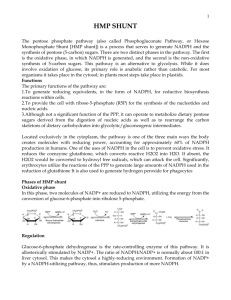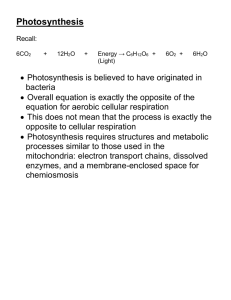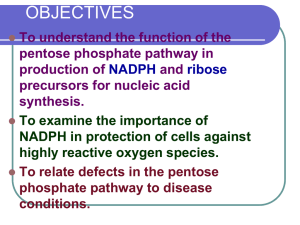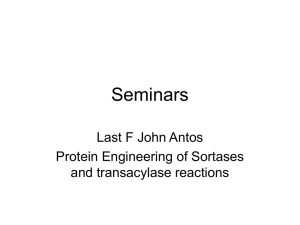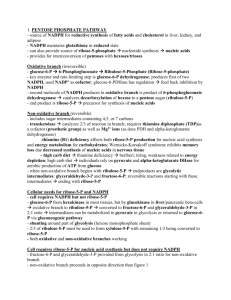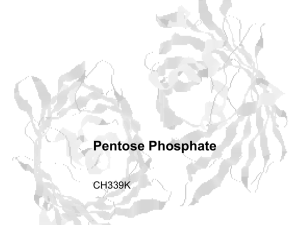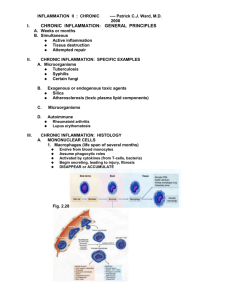2 - Dr rer. nat. Rubin Gulaboski
advertisement
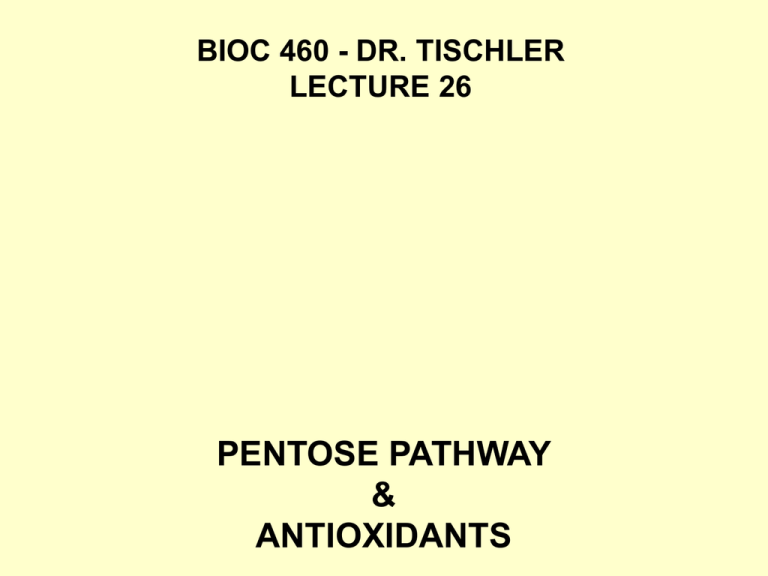
BIOC 460 - DR. TISCHLER LECTURE 26 PENTOSE PATHWAY & ANTIOXIDANTS OBJECTIVES 1. For the pentose phosphate pathway: a. describe the oxidative and non-oxidative branches b. describe how the oxidative branch is regulated c. distinguish between the 3 modes in terms of the roles of the potential endproducts of each mode. 2. Describe the consequences of thiamine deficiency 3. In relation to antioxidant function in the body: a. list the major active (reactive) oxygen species, identify the antioxidant which reduces that species. b. describe the metabolism of glutathione c. identify the enzymes that remove peroxides and superoxide radicals from a cell and name their cofactor. d. describe the relationships between the components of the antioxidant cascade including the reactions involved. e. discuss why a defect of glucose-6-phosphate dehydrogenase in the red blood cell might lead to loss of membrane integrity. PHYSIOLOGICAL PREMISE Do you have a partial enzyme deficiency about which you are unaware? There are circumstances where an individual may have such a partial deficiency but be unaware of the fact until a physiological event shifts the balance of metabolic processes. For example, individuals with malaria are given a drug called primaquine. When the body metabolizes primaquine it increases the demand for production of NADPH in most cells. A major source of NADPH is the glucose-6phosphate dehydrogenase (G6PDH) reaction in the pentose phosphate pathway. In the red blood cell, this pathway is essential for removing peroxides, which can oxidize lipids in the plasma membrane causing the cell to become more fragile. Stressing the system with primaquine in an individual with a partial deficiency of G6PDH will lead to red cell destruction and hence the individual becomes anemic. Functions of Pentose Phosphate Pathway 1) NADPH for biosynthetic pathways (e.g., synthesis of fatty acids and cholesterol); 2) NADPH for maintaining glutathione in its reduced state (see discussion of glutathione later); 3) Pentose sugar for synthesis of nucleic acids Glucose-6-P-DH NADP NADPH Glucose 6-P 6-Phosphogluconate NADP 6-Pgluconate DH NADPH glycolytic Ribulose 5-P CO2 intermediates Glyceraldehyde 3-P Xylulose 5-P Transketolase Glyceraldehyde 3-P Erythrose 4-P Nucleic acids Ribose 5-P TPP Transketolase Sedoheptulose-7-P Transaldolase Fructose 6-P Oxidative Branch Fructose 6-P Figure 1. The pentose phosphate pathway containing an oxidative and a non-oxidative branch Nonoxidative Branch Glyceraldehyde 3-P Fructose 6-P Transketolase Ribulose 5-P Nucleic acids Ribose 5-P Xylulose 5-P Transketolase Glyceraldehyde 3-P Erythrose 4-P Sedoheptulose 7-P Transaldolase Fructose 6-P Nonoxidative Branch Ribose-5-P is the sugar required for the synthesis of nucleic acids Figure 2. Using the non-oxidative branch of the pentose pathway to produce ribose-5-phosphate for the nucleic acid pathways (Mode 1). NADP Glucose 6-P NADPH 6-Phosphogluconate NADP Ribulose 5-P CO Oxidative Branch NADPH 2 Ribose 5-P Nucleic acids Figure 3. Using the oxidative branch of the pentose pathway to produce NADPH for biosynthetic reactions and ribose-5phosphate for producing nucleic acids (Mode 2). NADPH NADP 6-Phosphogluconate NADP Glucose 6-P (3) Ribulose 5-P (3) NADPH CO2 Oxidative Branch Glyceraldehyde 3-P (1) Xylulose 5-P (2) back to glucose-6-P or to glycolysis Glyceraldehyde 3-P (1) Ribose 5-P (1) Sedoheptulose 7-P (1) Erythrose 4-P (1) Fructose 6-P (1) Nonoxidative Branch Fructose 6-P (1) back to glucose-6-P or to glycolysis Figure 4. Using the oxidative branch to produce NADPH for biosynthesis and returning ribulose-5-P to glycolytic intermediates (mode 3) NUTRITIONAL PREMISE: THIAMINE (VITAMIN B1) used by transketolase, PDH, KgDH deficiency affects nucleic acid synthesis/energy metabolism Wernicke-Korsakoff syndrome – observed in alcoholics due to poor diet thiamine deficiency in individuals on high CHO diet (e.g., rice) causes beriberi • patients tire easily • cardiac decompensation • energy depletion on high CHO diet Brain atrophy due to Wernicke’s encephalopathy Slide to be shown in class Table 1. Reactive Oxygen Species and Antioxidants that Reduce Them Reactive Species Antioxidant Singlet oxygen 1O2 Vitamin A, vitamin E Superoxide radical (O2-) superoxide dismutase, vitamin C Hydrogen peroxide (H2O2) Catalase; glutathione peroxidase Peroxyl radical (ROO) Vitamin C, vitamin E Lipid peroxyl radical (LOO) Vitamin E Hydroxyl radical (OH) Vitamin C Lipid (LH) L OH Fe2+ O2 H2O LOO H2O2 1O 2 UV light heme Fe CoQ H2O, H+ H+ O2- O2 HOO NADPH or CoQ H+ Figure 5. Pathways for the formation of reactive oxygen species lipid radical Singlet oxygen Peroxyl radical Haber-Weiss lipid peroxyl reaction; Superoxide Superoxide dismutase radical radical anion Fenton reaction H2O2 2 GSH glutathione peroxidase glutathione reductase NADP+ 2 H2 O GSSG NADPH + H+ pentose pathway Figure 6. Reactions of glutathione reduction and oxidation SUMMARY OF ANTI-OXIDANT ENZYMES Glutathione peroxidase: 2 GSH + H2O2 GSSG + 2 H2O Uses selenium as a cofactor Catalase : 2 H2O2 H2O + O2 Lipid Peroxidase: removes LOOH Superoxide dismutase: 2 O2- + 2H+ H2O2 + O2 Mitochondrial - Mn2+ cofactor Cytoplasmic – Cu2+-Zn2+ cofactors; mutations associated with familial amyotrophic lateral sclerosis (FALS) NUTRITIONAL CORRELATE: SELENIUM selenocysteine in glutathione peroxidase intake may be related to lower cancer mortality • cancer patients have lower plasma Se levels • risk may be higher in those with low Se intake • AZCC study – reduced incidence of prostate, colon, lung cancers toxicity (> 1 mg/day) results in hair loss, GI upset, nerve damage lipid peroxyl radical rxn 5 LOO Vit Ered VIT Cox Glutathionered (GSH) rxn 6 LOOH VIT Eox Vit Cred rxn 7 +ROOH rxn 2 NADP+ rxn 1 Glucose-6-P Figure 7. Antioxidant cascade Reduced forms/reduction Oxidized forms/oxidation hydroxyl radical (OH) superoxide radical (O2-) rxn 9 reduced products Glutathioneox (GSSG) rxn 4 H 2 O2 2H2O NADPH + H+ Pentose phosphate pathway (rxn 8) Ribulose-5-P Medical Scenario: If the antioxidant protective system in the red blood cell becomes defective, hemolytic anemia occurs; that is red blood cells undergo hemolysis and their concentration in the blood decreases. Such is the case if glucose 6-phosphate dehydrogenase is defective in the pentose phosphate pathway. In individuals whose glucose 6-phosphate dehydrogenase is defective, there is insufficient NADPH produced in red blood cells to maintain the ratio of reduced glutathione to oxidized glutathione at its normal value of well over 100. Hence, peroxides destroy the red cell membrane because of the limited protective mechanism in these cells.
